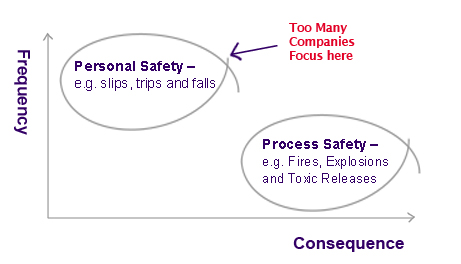1.1
What Process Safety Management means
Important Definitions
The UK Energy Institute defines Process Safety as:
“Process Safety is a blend of engineering and management skills focused on preventing catastrophic accidents and near misses, particularly structural collapse, explosions, fires and toxic releases associated with loss of containment of energy or dangerous substances such as chemicals and petroleum products."
-
For further reading click on the available resources.
"These engineering and management skills exceed those required for managing workplace safety.”

1.2
What Process Safety Management means
Important Definitions
The US Center for Chemical Process Safety (CCPS) defines Process Safety Management as:
“Process Safety Management (PSM) is a management system that is focused on prevention of, preparedness for, mitigation of, response to and restoration from catastrophic releases of chemicals or energy from a process associated with a facility.”
Occupational Safety vs Process Safety
It’s important for you to understand the major difference between Personal Safety and Process Safety. Personal Safety incidents (slips, trips and falls) are high frequency but with relatively low consequences incidents. However, Process Safety incidents can be seen as low frequency, but the consequences can be extremely serious in terms of fatalities, as well as environmental, property and reputation damage and business interruption."
In fact, a Process Safety accident can seriously damage or, at worst, destroy a company’s reputation and its financial viability.
1.3
What Process Safety Management means
The Risk of Complacency
Key Challenges
And here’s one of the key challenges of Process Safety.
Because of the relatively low frequency of accidents, staff may become complacent, whereas, ideally, they should be constantly vigilant, ready to detect and react to early warning signs.
For that reason, effective management of Process Safety can be difficult and challenging. That explains why the Energy Institute definition recognises that Process Safety has to be managed in a different way to Personal Safety.
Process Vs Personal Safety

1.4
What Process Safety Management means
Case Studies
A look at the causes and consequences of high-profile major disasters
You will now watch a series of videos which document high-profile disasters in the chemicals industry, including some programmes produced by the US Chemical Safety Board (CSB).
As a result of these incidents, many people – employees and members of the public – were killed, and many have suffered long term health effects. In some cases there was major damage to the environment. In all of them, the financial cost to the companies has been huge. This underlines the importance of Process Safety Management.
Video Case Studies
At this stage in the course you will simply watch the videos. For each incident you will be given outline information on the causes and consequences of the incidents. As the course progresses, you will build up detailed knowledge of the risks and hazards associated with the operations carried out in top tier chemicals companies. At various times throughout the course, reference will be made to these incidents.
1.5
What Process Safety Management means
Case studies
Flixborough 1974

The Flixborough explosion occurred at a chemical plant on 1 June 1974, close to the village of Flixborough, UK.
A temporary pipework modification ruptured at a bellows. Within a minute, about 30 tonnes of cyclohexane leaked from the pipe and formed a vapour cloud 100-200 metres in diameter.
On coming into contact with an ignition source, the cloud exploded, completely destroying the plant.
1.6
What Process Safety Management means
Case studies
Seveso 1976
A runaway exothermic reaction resulted in overpressure and a bursting disc rupture.
Around I kg of dioxin was released into the atmosphere.
A large area of land was contaminated and thousands of animals were slaughtered.
Hundreds of people suffered from chloracne, an acne-like skin eruption, and many women aborted pregnancy's fearing birth defects as a result of the release.
This incident lead to wide spread European concern relating to the control of these plants which resulted in the Sevesco directive, this was enacted in the UK under the COMAH regulations in 1999.
Seveso 1976
Many images are available which show the precautions required during the clean up, and the skin damage caused to victims.
Click on the links below to find out more.
1.7
What Process Safety Management means
Case studies
Bhopal
This incident was caused by water being added to a methyl isocyanate storage tank, causing an exothermic reaction.
The situation was made worse by the fact that many safety systems had either been disabled or not maintained.
40 tonnes of toxic gases were vented.
Thousands of people were killed.
1.8
What Process Safety Management means
Case studies
Mexico City LPG 1984
A Liquefied Petroleum Gas (LPG) pipe line between storage spheres failed, leading to LPG release which caught fire.
The flame impinged upon spheres, causing a Boiling Liquid Expanding Vapour Explosion (BLEVE).
This triggered a domino effect as one sphere after another exploded as the flames played on them and overheated them.
Housing had been built very close to the LPG storage site.
550 people were killed.
1.9
What Process Safety Management means
Case studies
Piper Alpha 1988
During a morning shift on the Piper Alpha oil rig, a spare pump was taken out of service for maintenance, but the maintenance crew didn’t actually start working on it. However, they removed a relief valve that was on the discharge pipework of the pump. That left an open flange, which they covered with a thin plate to prevent debris falling into the pipeline. This, however, did not provide the integrity required to contain pressure.
At the end of the day shift, the maintenance foreman handed in the work permit, but failed to confirm to the operators that the relief valve had been removed, because the operators were all busy, so he just left the permit on the desk. In short, there was a breakdown in communications.
On the nightshift, the online pump failed, and the crew, as they were faced with a major disruption to production. They figured that as no maintenance work had been done on the spare pump, they could recommission it, not realising that the relief valve was not in place.
Under pressure, the thin plate failed, and the pump began discharging its contents of highly flammable material into the middle of the production platform, which caught fire. That led to other fires – the so-called ‘spiral to disaster’ - and to other equipment overheating and failing. However, the immediate cause of the incident was a failure in the control of work.
169 people were killed, including two rescuers.
1.10
What Process Safety Management means
Case studies
Texas City Refinery 2005
This incident occurred during a plant start-up. In the process of introducing flammable liquid hydrocarbons into a raffinate splitter tower, used for distillation separation, operators lost control of the liquid level. They introduced feed, then established heat, but were fed inaccurate readings of the level, and failed to realise that they hadn’t opened the flow away from the column. In fact, all they were doing was pumping liquid into the distillation column.
This went on for some time, the column continued to fill and eventually overflowed, feeding down to a set of relief valves which discharged into a blow-down drum, which should have separated the liquid and gas and vented the gas into the atmosphere.
The blowdown tower was completely overloaded when the liquid filled it, and the liquid blew out the top like a geyser, forming a pool and spreading liquid and flammable vapours around the immediate area.
The vapours from this liquid subsequently ignited from a vehicle parked close by with the engine left running.
15 people were killed, mainly contractors who had been in a temporary building positioned too close to the unit.
1.11
What Process Safety Management means
Case studies
Buncefield 2005
Buncefield terminal imported and exported Gasoline (petrol). A high level shut-off switch, which shuts off feed if a tank is filled too high, had been taken out of service for inspection, but had been incorrectly re-installed, and so was no longer functional. The operators were importing gasoline by pipeline and they lost control of the tank level. They had a faulty level indication, and so didn’t realise that the tank had overfilled. The high level switch didn’t activate to stop the feed, and, in addition, didn’t warn them that the petrol was overflowing. The petrol overflowed the tank, ran down the side, and formed a mist which covered the whole of the site. This went on for some time. The column continued to fill and eventually overflowed, feeding down to a set of relief valves which discharged into a blow-down drum, which should have separated the liquid and gas and vented the gas into the atmosphere.
Eventually it found a source of ignition, and the major explosion and subsequent fire which followed destroyed the terminal. Fortunately, nobody was killed, but only because it was early on a Sunday morning.
The overall cost of the incident was estimated at £1 billion.
Buncefield
1.12
What Process Safety Management means
Case studies
Gulf of Mexico Oil Spill 2010
This crude oil production platform was operating in the deep sea with a water depth of approximately 1 mile.
In this incident, the operators lost control of the oil well and the oil gushed up to the surface, cascaded over the platform and caught fire.
This led to an explosion and fire, and the sinking of the oil rig. As the rig sank, it damaged the pipework which was used to bring the oil up from the seabed, and crude oil leaked into the sea for nearly 3 months.
It should have been possible to stop such a catastrophic leak through activation of the blow out preventer, which is designed to seal the well at the sea bed.
This failed to operate when it was activated from the platform, and subsequent attempts to activate it using an unmanned submarine at the sea bed also failed. 11 people were killed and extensive damage was done to the environment.
The cost is estimated at $40 billion.


 What Happened?
What Happened? The Consequences
The Consequences